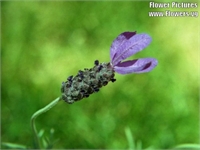
How to Grow and Maintain Lavender
Important Notice: Our web hosting provider recently started charging us for additional visits, which was unexpected. In response, we're seeking donations. Depending on the situation, we may explore different monetization options for our Community and Expert Contributors. It's crucial to provide more returns for their expertise and offer more Expert Validated Answers or AI Validated Answers. Learn more about our hosting issue here.

How to Grow and Maintain Lavender
You must be logged in to post a comment.
Growing and maintaining lavender will provide any gardener with luscious, fragrant blooms. Lavender can change a bare and unappealing landscape into a fragrant explosion of purple blooms. These highly fragrant blooms stand tall upon silvery-green stems, making them an ideal addition for lining driveways and walkways. Average bloom time for most lavender varieties is from early July to mid-September. The majority of lavender plants are propagated from cuttings, since producing strong, healthy lavender plants from seed is hit-or-miss. Gardeners that grow and maintain lavender in their own lanscape will love the sweet aroma drifting in the air.
Grow Lavender Cuttings
Once you have located healthy, mature lavender plants, you may begin to collect cuttings. Cuttings should only come from healthy lavender stems showing new growth. After the desired number of lavender cuttings are gathered, begin to ready them for the ground. Although not a requirement, lavender cuttings stand a greater chance of producing strong, attractive plants if each cutting receives a dip in rooting hormone. The rooting hormone encourages the lavender cuttings to sprout their own root system.
After placing the newly dipped lavender cuttings into moist, loose soil, the gardener should provide the cuttings with full sun. Lavender plants are extremely drought-tolerant and love to soak in at least six hours of continuous sunshine. The amount of water the lavender plants will need will depend on local weather conditions. Areas with extremely hot summers will require the gardener to water the lavenders every two or three days.
Maintain Lavender Plants
Once the lavender cuttings have rooted and they begin to show new green leaves, the surrounding ground should receive a weekly weeding to prevent a decrease in moisture and nutrient supply. Placing a thick layer of mulch around the lavender plant will help to deter hungry weeds from growing. One main problem many lavender growers face is fungal disease and rot caused by tightly spaced lavenders. A good rule of thumb when planting numerous lavenders, as a hedge or row, is to keep them spaced as far away from each other as they are wide. Growing lavender too close together will increase the growth of fungi.
Lavender Varieties
Lavender varieties are split into three groups: English, Non-English and Lavandins. Within each group, there are numerous kinds of lavender plants. A few common English lavenders include, Munstead, Hidcote, English, Sarah and Jean Davis. Non-English lavenders include, French, Sweet, Spanish and Yellow. Common Lavandin lavenders include, Fred Boutin, White Grosso, Provence and Grosso.
Each lavender group has its own characteristics that define that specific lavender plant. Lavandins are hybrids, which mean they are the result of crossing two lavender species together. These Hybrid lavenders take the place of English and Non-English lavenders in many landscapes due to their fast growth and larger mature size. Non-English lavenders are highly fragrant and bloom the earliest in the season, starting early to mid-spring. English lavenders begin to bloom in mid- to late-spring.
Uses of Lavender Plants
Not only does growing and maintaing lavender provide a rich, heady scent, but the lavender buds also provide fresh cuttings to use for various projects. After the lavender plants begin to burst forth with bright purple blooms, their thin flower stems are ready for harvesting. Dried lavender stems are used in many craft projects, such as wreaths, candle-making, potpourri and oil extraction. Chefs often use the dried lavender buds in cooking to take advantage of the flower bud’s sweet fragrance.
Lavender Afterthoughts
Although propagating lavender plants from cuttings remain the most common method of growth, sowing lavender seeds is probable. The lavender seeds will need daily care and attention to avoid common problems such as fungal growth and rot.